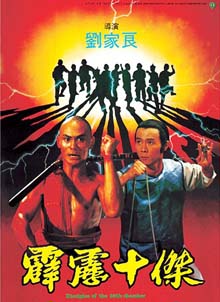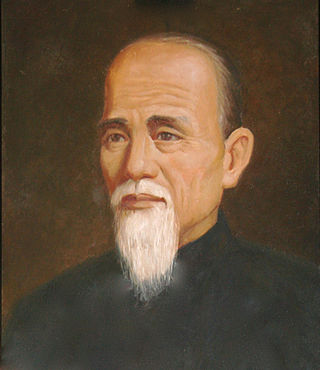
Shaolin kung fu, also called Shaolin Wushu, or Shaolin quan, is the largest and most famous style of kung fu. It combines Chan philosophy and martial arts. It was developed in the Shaolin Temple in Henan, China during its 1500-year history. In Chinese folklore there is a saying, "Shaolin kung fu is the best under heaven," which indicates its superiority among martial arts, and "All martial arts under heaven originated from Shaolin," which indicates its influence on other martial arts. The name Shaolin is also used as a brand for the so-called external styles of kung fu. Many styles in southern and northern China use the name Shaolin.

Hung Ga (洪家), Hung Kuen (洪拳), or Hung Ga Kuen (洪家拳) is a southern Chinese martial art belonging to the southern Shaolin styles. The hallmarks of Hung Ga are strong stances, notably the horse stance, or "si ping ma" (四平馬), and strong hand techniques, notably the bridge hand and the versatile tiger claw. Traditionally, students spent anywhere from several months to three years in stance training, often sitting only in horse stance from half an hour to several hours at a time, before learning any forms. Each form could then take a year or so to learn, with weapons learned last. In current times, this mode of instruction is generally considered impractical for students, who have other concerns beyond practicing kung fu. However, some instructors still follow traditional guidelines and make stance training the majority of their beginner training. Hung Ga is sometimes mischaracterized as solely external—that is, reliant on brute physical force rather than the cultivation of qi—even though the student advances progressively toward an internal focus.

Fong Sai-yuk is a semi-fictional Chinese martial artist and folk hero from Zhaoqing City, Guangdong Province of the Qing dynasty. Fong was also associated with Hung Hei-gun and the Five Elders of the Southern Shaolin Monastery. He was a disciple of Shaolin and his martial arts techniques were considered to have contributed to the development of Hung Ga Kuen.

Return to the 36th Chamber is a 1980 Shaw Brothers Studio Hong Kong martial arts comedy film starring Gordon Liu. It was directed by Lau Kar-leung and written by Ni Kuang. The film is the second in a loosely connected trilogy, following The 36th Chamber of Shaolin (1978) and preceding Disciples of the 36th Chamber (1985). In the first and third films in the series, Liu portrays the Shaolin monk San Te, but in Return, he portrays an imposter monk.
Gordon Liu ; born Sin Kam-hei is a Chinese actor and martial artist best known for his martial arts films.

Disciples of the 36th Chamber is a 1985 Shaw Brothers Studio Hong Kong martial arts film comedy written, directed and choreographed Lau Kar-leung. It is the third in a loose trilogy of films that began with The 36th Chamber of Shaolin (1978) and was followed by Return to the 36th Chamber (1980). In Disciples, the action is focused on Hsiao Ho, who portrays legendary martial artist Fong Sai-Yuk. Gordon Liu, a constant in the 36th Chamber series, reprises his role from The 36th Chamber of Shaolin as the monk San Te.

Five Deadly Venoms, also known as The Five Venoms, is a 1978 Hong Kong martial arts mystery film directed and co-written by Chang Cheh and produced by Runme Shaw for the Shaw Brothers Studio. It stars Chiang Shieng as Yang Tieh, a martial arts pupil who aims to follow his master's dying wish: to find the new identities of the master's five previous pupils, and kill them if they have turned towards evil. While doing so, Yang stumbles onto a web of murders and investigations involving all five pupils. Each of the master's previous pupils practices a unique animal-themed style, with the animals being based on the Five Poisonous Creatures of Chinese folklore.
Lau Kar-leung was a Hong Kong martial artist, filmmaker, actor, and fight choreographer. He is best known for the films he made in the 1970s and 1980s for the Shaw Brothers Studio. His most famous works include The 36th Chamber of Shaolin (1978) starring Gordon Liu as well as Drunken Master II (1994) starring Jackie Chan.
San Te or San-De monk was a Shaolin martial arts disciple who trained under monk Zhi Shan. The title San-De means "Three Harmonies" or "Three Virtues". He lived in the early 18th century and resided at the Xichan Monastery after leaving the main Shaolin Monastery.

Shaolin and Wu Tang is a 1983 Hong Kong martial arts film directed by and starring Gordon Liu. The film is about the rivalry between the Shaolin and Wu-Tang martial arts schools. It is also called Shaolin vs. Wu-Tang in the Master Killer Collection.
Hsiao Ho, is a Hong Kong martial arts film actor, stunt performer and action choreographer. A Hakka, he has acted in many films directed by Lau Kar-leung, including Mad Monkey Kung Fu and Legendary Weapons of China. In 1985 he portrayed legendary kung fu warrior Fong Sai-Yuk in the Lau directed action-comedy, Disciples of the 36th Chamber and also took a lead role in Fake Ghost Catchers, directed by Lau Kar Wing. Fake Ghost Catchers is marketed by Celestial Pictures as being made two years before Ghostbusters. Hou is also known for portraying the "disfigured swordsman" and doubling complicated action scenes in 1993's Iron Monkey. He was also the action director for the movie Shaolin Avengers (1994). In 1982 he was nominated for Best Action Choreography for the movie Legendary Weapons of China at the Hong Kong Film Awards alongside Lau Kar Leung and Ching Chu who also provided choreography for the film.

Five Shaolin Masters, a.k.a. 5 Masters of Death, is a 1974 Shaw Brothers kung fu film directed by Chang Cheh, with action choreography by Lau Kar Leung and Lau Kar Wing.

Shaolin Temple, a.k.a. Death Chamber, is a Shaw Brothers film directed by Chang Cheh. It is one of the Shaolin Temple themed martial arts films and concerns their rebellion against the Qings, with an all-star cast featuring the second and third generations of Chang Cheh's stable of actors including David Chiang, Ti Lung, Alexander Fu Sheng and Chi Kuan Chun, as well as cameo appearances by several of the actors that would later become collectively known as the Venoms mob. The film serves as a pseudo-prequel to Five Shaolin Masters.

Abbot of Shaolin (少林英雄榜), also known as Shaolin Abbot or A Slice of Death, is a Shaw Brothers film directed by Ho Meng Hua. It is a Shaolin Temple-themed martial arts film about their rebellion against the Qing, featuring David Chiang and Lo Lieh as Priest Pai Mei.

Chan Shen was a Taiwanese-born Hong Kong film actor. He is best known for his roles as gangsters or villains in Hong Kong action cinema in the 1970s.

Chan Heung was the founder of the Choy Li Fut martial arts system.
Carter Wong is a Hong Kong actor and martial artist, who is mainly known for roles in Kung Fu action movies. The biggest movies he was featured in are Big Trouble in Little China (1986), and Yong zheng ming zhang Shao Lin men (1977). As an actor, he contributed to more than seventy martial arts films. He also worked as a stuntman in films, and was the fighting instructor for the movie Rambo III. Wong is still active in martial arts.
Phillip Ko-fei was a Hong Kong–based actor, screenwriter and film director.
Chui Chung-San was a Hong Kong actor, director, choreographer, martial artist and stuntman. He was known for being an action director and stuntman. Chui was known for films such as The Rebellious Reign, Kung Fu Vs. Yoga, Two Fists Against the Law and 7 Grandmasters as well as other various Hong Kong and Taiwanese television shows.

Lee Hoi-sang was a Hong Kong martial arts film actor and martial artist, known for his roles in The 36th Chamber of Shaolin (1978), Shaolin Challenges Ninja (1978), The Incredible Kung Fu Master (1979), The Young Master (1980), The Prodigal Son (1981), Project A (1983), Shaolin and Wu Tang (1983) and Disciples of the 36th Chamber (1985), alongside actors such as Jackie Chan, Gordon Liu, Sammo Hung, Yuen Biao and Bolo Yeung.











